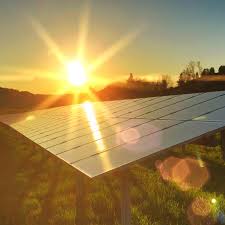What is a Solar PV cell and module?
Solar PV cell is the basic building block of a PV system. It consists of semiconductor material that absorbs sunlight to generate electricity through a phenomenon called “photoelectric effect”. Only sunlight of a certain wavelength can effectively generate electricity. Even on a cloudy day a solar PV can generate optimum electricity .
A basic PV cell produces a very small amount of electricity and multiple of them are connected together to form a Solar PV module that can generate 10W to 300W output. If more electricity is required, them multiple such PV modules have to be installed in an array.
Multiple kinds of materials are used to create a solar cell and the efficiency of solar cell depends on the same. The efficiency of a solar cell is defined as its capability to convert a certain amount of sunlight into electricity. Solar cells available in the market are of various efficiencies: 4%, 8%, 12%, 14% and 16%. The size of a Solar PV module required will depend on output and efficiencies:
Sizing a solar system
Before you buy a system, it is very important to size your solar system properly. Sizing will depend on the load requirements in your setup. It is very important to make sure that your system is energy efficient so that you do need a bigger sized solar system. The connected load of your setup will help you determine the size of system that you need and that in turn will drive the cost of the system.
Other considerations for installing a solar system
Although a solar PV system can generate electricity through direct or scattered sunlight but it is very important to assess the amount of sunlight available at the location where a solar PV system is being installed. To collect maximum sunlight the ideal orientation of a Solar Panel is towards south. However a 45-degree east or west of south can also work. The system should be placed in such a place so that there is no obstruction of trees or adjoining building. In case these requirements are not getting fulfilled, an expert should be hired to do a detailed analysis on the amount of sunlight available. The load carrying capacity of the roof where the solar panels are to be installed should also be done. Solar Panel structure typically weight 15kg per sq meter and the roof should be able to handle the load.
Tilt at which the solar panel is installed is also an important consideration. It is important that the tilt of the solar panel is the same as the latitude of your location.
System output or electricity units generated from a solar system
Although we talked about wattage capacity of a solar PV system, but that does not mean that the wattage will be available 24 hours a day and all throughout the year. The units or kWH output of a solar panel will depend on the panel efficiency and availability of sunlight in a location. The factor that defines this output is called CUF (or Capacity Utility Factor). For India, it is typically taken as 19% and the calculation of units goes as:
Units Generated Annually (in Kwh) = System Size in Kw * CUF * 365 * 24
So typically a 1kW capacity solar system will generate 1600-1700 kWH of electricity per year (please note that this is just a thumb rule as the CUF will vary in different cities in India).
Warranties and Maintenance requirements for a Solar PV system
Generally a Solar PV module comes with a warranty of 25 years from the date of supply. A solar home lighting system (with inverter) comes with a warranty of 5 years and the batteries if sealed maintenance free come with 2 years warranty and lead acid flooded type battery comes with 5 year warranty.
Go solar and reduce electricity bill at home:
- Click here to contact us online
- Call us at +91-920-569-5690
- Simply fill the form below

